|
|
|
|
| |
| |
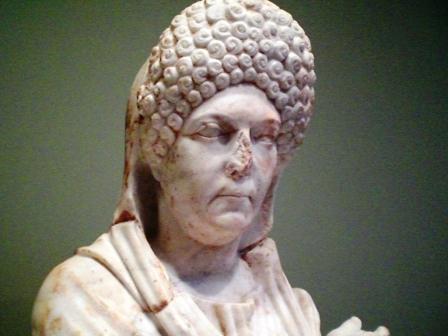
Mature Woman of the Roman Elite,
Marble Bust, 1st c AD
Flavian Era. Getty Villa
For more on hairstyles:
Glorious Roman Hairstyle Photos
Highlights
* Women of the upper classes could read and write, sometimes Greek as
well as Latin. Unfortunately, almost nothing written by a woman of
ancient Rome has survived. We know of them only through male writers.
* Women outside the elite, even those working in necessary occupations,
were not esteemed.
* Women were portrayed in art as symbols of specific Roman
values--fertility, motherhood, etc.
* The status and role of women changed little over a thousand years of
Roman history.
|
|
Notable Women of Ancient Rome
Notable women were all upper class women: rich,
protected, beautifully adorned. Like males of the upper classes of
Rome, these females were extraordinarily privileged.
How do we know who they were?
This is a big problem: Roman
women have come down to us only through male writers of the ancient
world and beyond. These writers wrote only about the women of the political
elite.
Not surprisingly, Roman women flit in and out of our attention space--a
paragraph here by a Roman historian, a mention there by Cicero in his
letters.
Sometimes there were statues or games or other honors by a husband. A
wife's honors were partly
meant to extol the husband's own virtues, especially if he were in politics.
|
|
|
|
|
|
|
|
Notable Women We Wish We Knew More About: |
|
|
|
|
Tullia (legendary), 6th c BC.
Tullia was a
symbol of parricide, the worst of all crimes in
Roman eyes.
Livy the historian tells us that Tullia, the daughter of a very early King of Rome, conspired with her husband to kill her father.
This enabled her husband
to become ruler of Rome.
Tullia then ran over Dad's dead body in her
carriage, underlining the heartlessness of the murder.
Tullia was still
in use as a moral symbol as late as the 19th c. (see photo right).
|
|

Tullia Driving
Over the Dead Body of Her Father,"
by Ernst
Hildebrand, 1889. New York Public Library.
|
|
|
|
|
|
|
|
|
|
|
|
|
Lucretia (legendary),
6th c BC
Lucretia
was Roman virtue personified.
Lucretia has been the subject of myth and literature for centuries, including Rembrandt's
painting and Shakespeare's poem, "The Rape of Lucretia."
Who was
she, this object of so many centuries of attention?
Lucretia
was the wife of a nobleman, and of course beautiful and virtuous.
Although she was in a privileged social position, the
son of the then-King of Rome raped her.
Lucretia extracted from her
father and her husband an oath of vengeance against the
King's
family.
Then she stabbed herself to death.
Why did she, the
victim, kill herself? Roman notions of honor portrayed rape
as dishonoring the husband and the family more
than the woman.
|
|
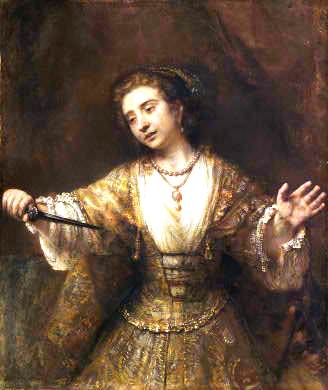
"Lucretia"
by
Rembrandt van Rijn. Oil. 1664. National Gallery,
Washington, DC. (Photo courtesy National Gallery).
Postscript:
The King's own second-in-command leveraged the event of Lucretia's rape
into a rebellion to overthrow the King.
Traditionally dated 509 BC, the rebellion is the foundation of the Roman Republic.
|
|
|
|
|
|
|
|
|
|
|
|
Cornelia, 2nd c BC
Cornelia was the
iconic early Roman mother, wife, and intellectual.
The ancients gobbled up romantic "political reconciliation"
stories and Cornelia's was the best.
Cornelia supposedly sacrificed her own wishes in order to
reconcile two rich, powerful and warring noble families "for the good of
Rome." She did this by marrying a bitter enemy of her father's, T. S.
Gracchus. He was
also 25 years older than she.
Known as "Mother of the Gracchi," Cornelia had twelve children, of whom
three survived infancy.
An early-adopter of Greek culture,
Cornelia was a published writer
whose works, lost to us, were admired in the ancient world. |
|

Cornelia,
mother of the Gracchi. "Cornelia
Presenting Her Children, the Gracchi, as Her
Treasures," Oil. Angelika
Kauffmann, 1785. Virginia Museum of Fine Arts.
Photo Courtesy Va. Museum.
Cornelia is
supposed to have said: "My children are my
jewels."
In fact, Cornelia had an enormous
dowry and enjoyed a lavish lifestyle.
Lavish
apparently was ok as long as it was tasteful. |
|
|
|
|
|
|
|
|
Hortensia, 1st c BC
Hortensia
was the first woman to make a speech in the Roman Forum.
After Julius Caesar's assassination in 44 BC, the new rulers (the Triumvirate sought revenge for
his murder. With money for civil war against the assassins in short
supply, they proposed taxing the property of the 1,400 richest Roman
women.
Hortensia led a delegation of women to Forum, where she declared
that Roman women would enthusiastically help resist a foreign enemy but
would never pay for a civil war.
(Exactly what she said has come down to us in a muddle of fabrication
and speculation).
|
|
Needless to say, Hortensia would not have been invited by the Roman male
political establishment to make a
speech, especially not this speech.
But she prevailed. The
number of women liable to the tax was reduced to 400, and Roman males
who owned property were
now also taxed. |
|
|
|
|
|
|
|
|
Terentia, Tullia, and Publilia,
1st c BC
These three are the only women known to us from private letters.
They were the wives and daughters of Cicero.
Terentia was his first wife. Tullia was their daughter.
Publilia was his much,
much younger second wife. It was not a match made in heaven. Cicero wrote
extensively to his friends about the
three females in his life.
In addition, there were lots of letters between Cicero and his wives and daughter. Cicero's side of the letters have survived.
|
|
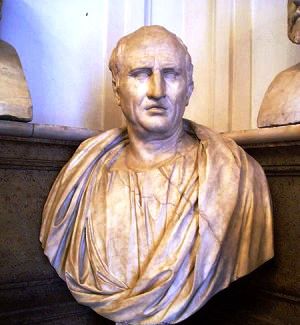
Cicero.
Marble bust. Capitoline Museum, Rome |
|
|
|
|
|
|
|
|
Octavia, 1st c BC
Octavia was one of the first Roman
women whose likeness appeared on an official coin.
Octavia was the sister of Octavian, Julius Caesar's nephew and heir,
who became Rome's first
Emperor, (and changed his name to Augustus.) Brother Augustus delivered Octavia's funeral oration,
an unusual honor for a woman, and built the Gate of Octavia, still
standing, in her memory.
Octavia was also the (4th) wife of Mark Anthony. Being by all
accounts a good
person, she took care of Mark Anthony's children by his third wife.
This called for a very big heart indeed, as Mark Anthony then abandoned Octavia for Cleopatra.
Unfortunately, Octavia's great goodness could not prevent
outsized badness in her offspring. Her direct descendants were among the
most horrible of all Roman Emperors--Caligula, Claudius, and Nero. |
|
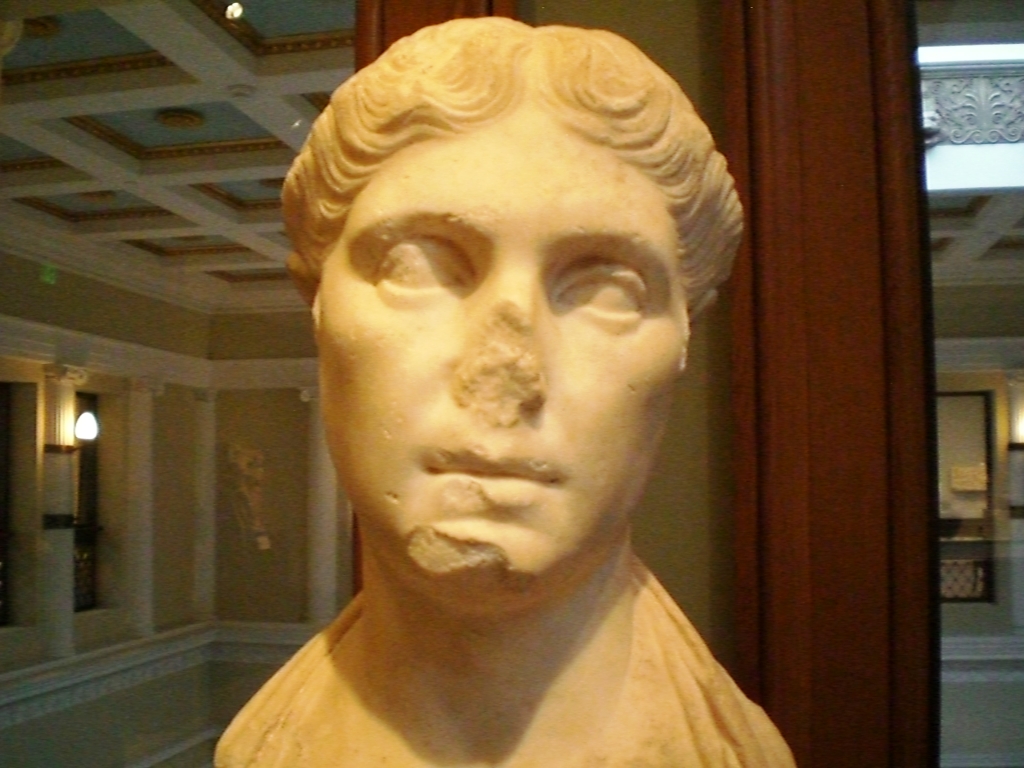
Octavia. Marble bust. 1st c. Getty Villa.
The poet
Vergil admired Octavia. She reportedly fainted when Vergil read his verses of poetry
to the Emperor.
|
|
|
|
|
|
|
|
|
Fulvia,
1st C BC
How Not to Be a "Good
Roman Wife."
Fulvia was Mark Anthony's
first wife, and she represents the aggressive,
independent, political woman of the late Roman
Republic. Although women are now figuring more
prominently in historical accounts, their "appropriate"
role appears not to have changed all that much from
500 years previously.
Fulvia's ultimate
transgression was her foray into a sphere outside
the old role of the Good Roman Wife. Here's how the
story goes, from the male writers of ancient times:
After Julius Caesar's death,
civil war raged between his nephew Octavian/Augustus
and Mark Anthony. Fulvia supposedly appeared before
husband Anthony's troops while Anthony was on
another front. She urged the troops to stand loyal to
him against Octavian. She held councils of war with
Roman senators. She put on a sword. She issued the watchword
to the troops.
|
|
Still, Anthony's troops,
led by his brother, were defeated. And guess what?
Anthony blamed Fulvia for
the rout.
When she lay dying, he did not
visit her.
End of the ancients' version of the story.
We are left wondering: beneath this history, is there another
story?
|
|
|
|
|
|
|
|
|
Livia, 58 BC- AD 29
Loyal and supportive wife, or ruthless plotter and poisoner?
Livia was Emperor Augustus' second wife. She was considered a fine
example of a Roman "matrona."
Livia wore neither excessive jewelry nor
pretentious costumes, took care of the household, and was loyal to
her husband. For thirty years, Livia stayed in the imperial
background, in the shadow of Augustus' sister, Octavia (wife
of Mark Anthony). Augustus dedicated a public statue to Livia.
Livia's villa north of Rome was famous for its beautiful frescoes,
now in Rome at the
National Museum delle Terme,
Palazzo Massimo. (The "House of Livia" on the Palatine Hill was not built by or
for Livia.)
Livia had her own circle of political clients and pushed many protégés
into political offices. She just as energetically pushed others out. Livia
certainly had a hand in the exile of stepdaughter Julia the Elder and
her daughter Julia the Younger.
She tirelessly campaigned for
her son Tiberius, from an earlier marriage, to become Emperor upon Augustus' death.
She succeeded.
The ancient scandal-mongers relish
telling how Emperor Tiberius soon tired of Mom's influence: Tiberius exiled himself
to get away from Livia. He did not even attend
her funeral. |
|
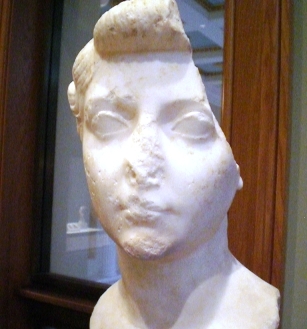
Livia.
Marble Bust (fragment). 1st c. Getty Villa.
Livia was around 60 when this portrait bust was
made, but she wanted to be pictured as youthful.

Livia depicted as Pax, goddess of Peace.
Roman gold coin ("aureus") 36
AD. On the other side of the
coin is her son, the Emperor Tiberius.
|
| |
|
|
|
|
|
|
|
|
|
|
Julia the Elder,
39 BC-AD 14
The Wild Child
Julia the Elder was the only child of the
Emperor Augustus. She was witty, smart, kind to people, and beloved,
at least at first, by her father.
But all the major male ancients
considered her the symbol of female profligacy.
Julia had an affair(s?) and partied
wildly with Roman patricians, including the son of Mark Anthony,
Dad's old nemesis.
It's not
too hard to figure out why: on the day of Julia's birth her father divorced
her mother, Scribonia, and took Julia away. When Julia was two, Dad
engaged
her to a political ally's son, though this marriage never took place.
When she was fifteen, Father married her off to her first cousin, Aunt Octavia's
son Marcellus.
Marcellus died only two years later, and she was handed off again to a
man 25 years her elder, Agrippa. By chance, they were quite happy and
had several children.
But husband Agrippa died, and Dad Augustus forced her
too quickly into a 3rd marriage to step-brother Tiberius. At the time,
Tiberius was married to someone else, to whom he was truly attached. The
marriage was a disaster for both Julia and Tiberius, and it ended in
divorce.
For her adultery and "treason," her father exiled
her to a small, uninhabited island. Later he let her return to a town in
the "toe" of Italy.
|
|
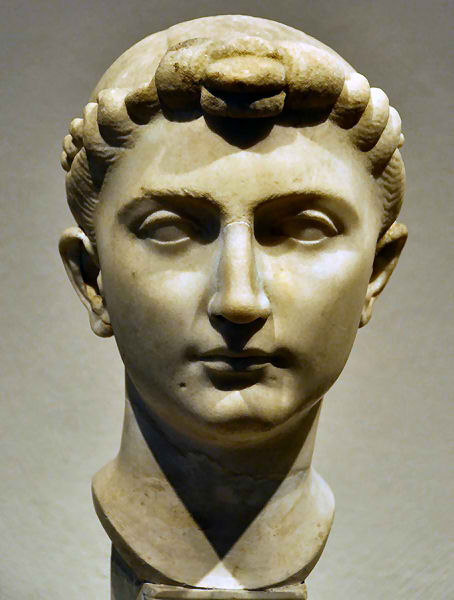
Julia, (probably),
daughter of Augustus. 1st c. Marble bust. Altes
Museum, Berlin.
Postscript: Father eventually died.
Julia's ex-husband Tiberius became
Emperor. Tiberius exacted revenge upon poor Julia for the humiliations
he had suffered from her wild affairs: Julia was forced to live in
one room of her house with no human contact.
Julia died soon thereafter.
Tiberius may have starved her to death, or she committed suicide, or both. |
| |
|
|
|
|
|
|
Sulpicia, 1st c AD Sulpicia is the
only woman whose writings, Latin poetry, have survived.
Sulpicia is thought to have lived during the
reign of the Emperor Augustus. Six of her love poems have survived.
Sulpicia's poems were published with those of a male poet; for centuries
they were thought to be his.
|
|
Scholars now think they
have found other fragments by Roman women poets.
They have found 2 lines by
Sulpicia Caleni, 45 lines by Julia Balbilla on a Colossus in Egypt, and an inscription on a pyramid. |
|
|
|
|
|
|
|
|
|
|
|
|
Agrippina the Younger,
1st c AD
She wrote memoirs, now lost, that were admired by Tacitus and Pliny the Elder.
Agrippina is also credited with murdering people, evidently many people, including her
third husband and uncle, the Emperor Claudius. She allegedly presented him with a
plate of poisoned mushrooms at a banquet.
She herself was perhaps murdered by her son the Emperor Nero. Nero had
her assassinated after a very contrived boating accident failed to do so. |
|
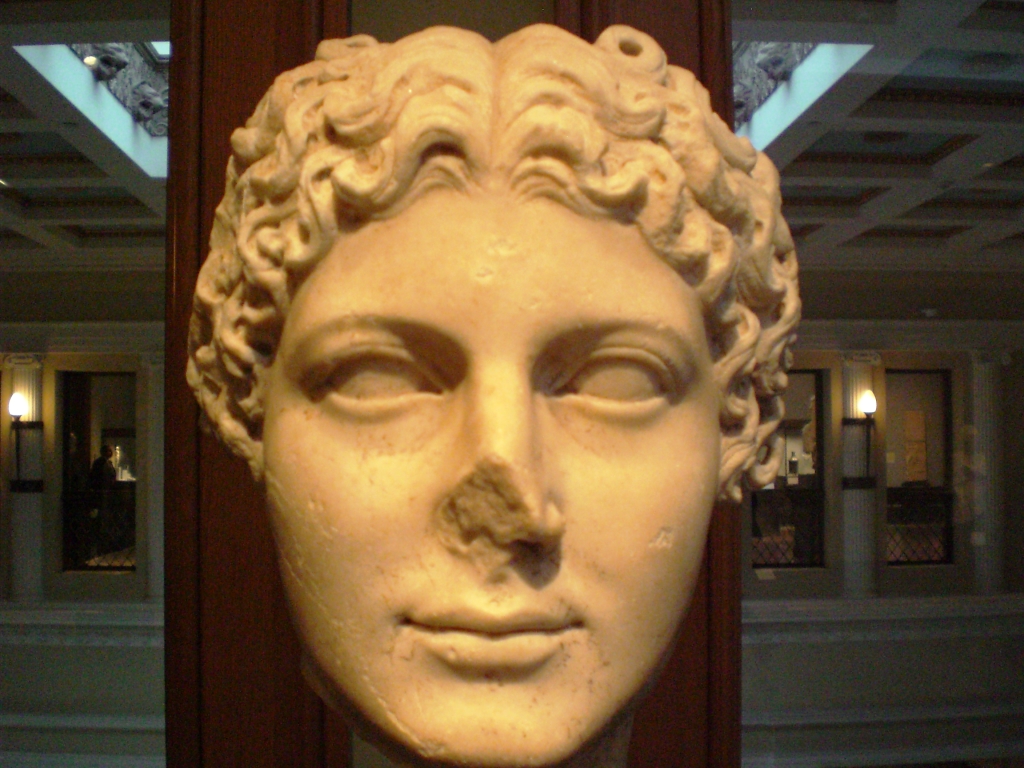
Agrippina the
Younger. Marble bust. 1st c AD. Getty
Villa. |
| |
|
|
|
|
|
|
|
|
|
|
Julia Domna, 2nd c AD Well-read, well-educated,
and well-heeled.
Julia accompanied her husband the Emperor
Septimius Severus on his military campaigns, highly unusual for a wife.
His campaigns included England, at that time a scary and wild
place.
Julia was also a serious student of philosophy and a
noted patron of the
Sophist philosophers.
Her son Caracalla was not so wonderful. When his father the Emperor died,
Caracalla promptly murdered his younger brother, Geta, to gain the
throne.
Julia Domna
apparently forgave all, because she accompanied son Caracalla on his
military campaigns.
Julia Domna committed suicide after Emperor Caracalla was assassinated by a
fellow army officer. |
|
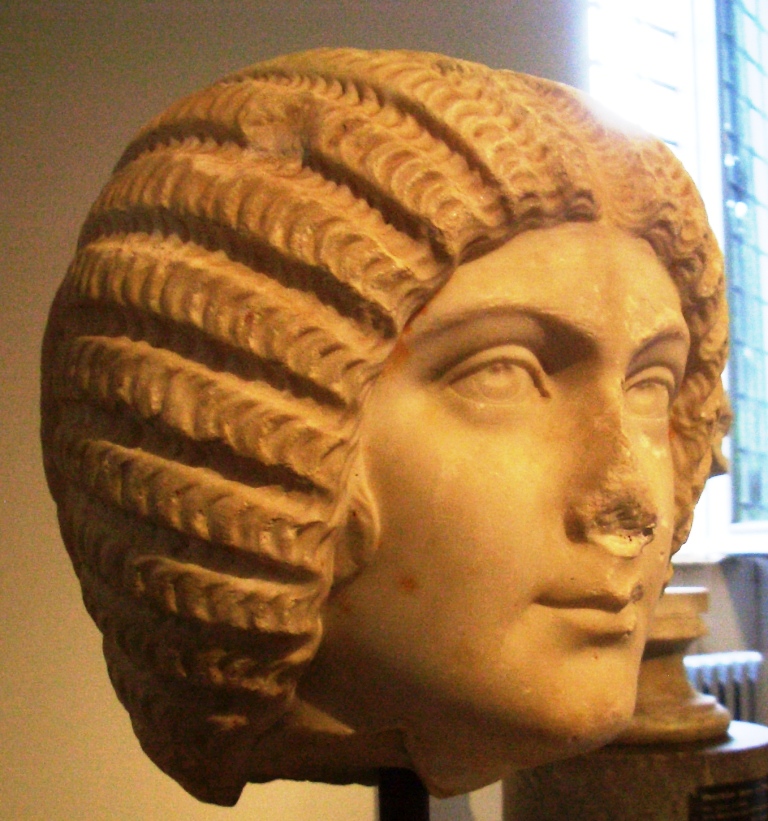
Julia Domna.
Marble Bust, 2d c AD. Palatine Museum.
|
|
|
|
|
|
|
|
|
|
|
|
|
Women of the Late Empire
In the later Empire, the city of Rome and
its old Roman Senatorial political
and social elites lost importance. The Army, rather than the
senators or the sitting emperor might make or break an Emperor.
Usurpers abounded. There sometimes were as many as four
emperors ruling at the same time.
The Emperor's seat moved all over the
map--Trier, Milan, Ravenna, and finally settled on two capitals, one in
Constantinople and the other in the West (Ravenna, Italy).
Many Emperors and other top Imperial officials
were born outside Rome, and some Emperors did not set foot in Italy for
most of their reign. A few were from obscure social origins. The Late
Empire was a fluid mixture of "barbarians"-- those not culturally
Roman-- and the old Roman elites.
The lives of the wives of the late Emperors reflected these changes.
Galla Placidia, 5th c. AD
Many Roman empresses
were children of Roman Emperors
who moved between barbarian and traditional Roman Imperial families.
A good example is Galla Placida. Placidia, involved in Imperial
political life for most of her own life, was the daughter of a Roman
Emperor (Theodosius I) and his wife, herself the daughter of an earlier Roman
Emperor.
Placidia was raised in the household of a "barbarian" Stilicho the
Vandal and his wife, Serena, and engaged to their son. She eventually
married a Visigoth ruler, Ataulf. Ataulf was
assassinated, and she was married off to a traditional Emperor,
Constantius III.
With him, they had a future Emperor of the Western Empire, Valentinian
III.Barbarian women
Barbarian women were considered by the Romans to be strong,
sometimes acting more manly than their mates.
Barbarian marriages were considered very solid.
Barbarians were invariably depicted as
living in cold climates with only a few skins for clothing.
Above all, they lacked
urban settlements and the city's resulting high culture.
Based on a pastoral economy, barbarians ate peculiar food-- dairy
products, meat, bird's eggs, not the grains or olive oil of the Roman
Mediterranean economy. Early Christianity and Roman Women
Some women
found Christian religious institutions, usually a nunnery, a welcome new
option for their lives. More on this topic later...
|
|
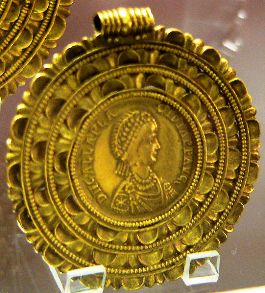
Galla Placidia.
Medallion. 5th c AD.
Gold. Bibliotheque National, Paris.
This medallion was struck by
Placidia's brother, the
Emperor Honorius. One of the more
powerful women in Late Imperial politics, Galla
Placidia was a devout Christian.
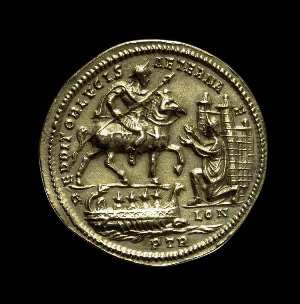
Barbarian woman
surrendering to Roman conqueror. Roman Coin, called the Arras
Medallion. British Museum, London.
The woman represents barbarian London and the
conqueror is Emperor Constantius.
"Barbarians in
submission" are one of the longest-lasting
conventions in Roman art. |
|
|
|
|
|
Updated 04-August-2015. You may contact me, Nancy Padgett at
NJPadgett@gmail.com |
|
|
|
|
|
|